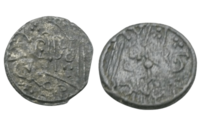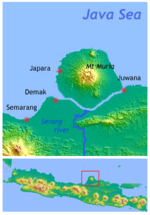Demak Sultanate facts for kids
Quick facts for kids
Sultanate of Demak
|
|||||||||||
|---|---|---|---|---|---|---|---|---|---|---|---|
| 1475–1554 | |||||||||||
|
Coinage of Raden Patah, possibly minted around 15th to 16th century, The coin is displayed at Sumatran Numismatic Museum in Medan. Obverse: سلطان دمق فقرن الفـَـاتح (Sultan Demak Pangeran al-Fatih (Raden Patah)), Reverse: محمد صل وسلم عليه (the Shalawat); both written in the perso-arabic script.
|
|||||||||||
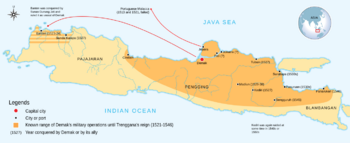
Known range of Demak's military operation until the reign of Sultan Trenggana (1521–1546)
|
|||||||||||
| Status | Vassal state of Majapahit (1475–1478) |
||||||||||
| Capital | Bintara, Demak | ||||||||||
| Common languages | Javanese | ||||||||||
| Religion | Sunni Islam | ||||||||||
| Government | Sultanate | ||||||||||
| Sultan | |||||||||||
|
• 1475–1518 1
|
Raden Patah | ||||||||||
|
• 1518–1521
|
Pati Unus | ||||||||||
|
• 1521–1546
|
Trenggana | ||||||||||
| History | |||||||||||
|
• Foundation of Demak port town
|
1475 | ||||||||||
|
• The capital city of Demak was moved to Pajang by Sultan Hadiwijaya
|
1554 | ||||||||||
|
|||||||||||
The Demak Sultanate (کسلطانن دمق) was the first Muslim kingdom in Java, Indonesia. It was located on Java's north coast, where the city of Demak is today. Demak started as a small port town that belonged to the Hindu-Buddhist Majapahit kingdom in the late 1400s.
Muslim traders from places like China, Gujarat, and Arabia brought Islam to the region. Islamic kingdoms like Samudra Pasai and Malacca also influenced Java. The Demak Sultanate quickly grew to control much of Java's northern coast and parts of southern Sumatra.
Even though it lasted for just over a century, Demak was very important. It played a big role in spreading Islam throughout Indonesia, especially on Java and nearby islands.
Contents
What Does "Demak" Mean?
The area where Demak began was first called Glagah Wangi. This name means "fragrant swamp." Later, it was renamed Demak Bintara.
Historians have different ideas about where the name Demak came from. Some think it comes from the Javanese word delemak, meaning "watery soil" or "swamp." This makes sense because the area was quite wet.
How Did Demak Begin?
Early Influences
In the early 1400s, large Chinese naval expeditions led by Admiral Zheng He visited Java. Zheng He was a Muslim Chinese admiral. These visits helped Muslim communities grow in northern Javanese ports like Semarang, Demak, Tuban, and Ampel. This is how Islam started to become strong on Java's north coast.
Demak was founded in the late 1400s by a Muslim leader named Raden Patah. He was also known as "Pate Rodin" by the Portuguese and "Jin Bun" by the Chinese. Some records suggest he had Chinese family roots.
Raden Patah, the Founder
According to old stories, a respected Islamic teacher named Sunan Ampel told Raden Patah to create an Islamic learning center. This center was in a village called Glagah Wangi, on Java's coast. Soon, this village became a hub for important Islamic teachers, known as the Wali Songo (the nine saints).
At first, Glagah Wangi was a small area under the Majapahit kingdom. It was special because it was the only Majapahit area with a Muslim ruler. The village was renamed Demak and grew with the establishment of Islamic schools.
Raden Patah (who ruled from 1475–1518) is traditionally seen as the founder of Demak. He was a Javanese noble with ties to the Majapahit royal family. Some stories say he was the son of King Kertabhumi, a Majapahit ruler.
When the Majapahit kingdom started to weaken and face internal conflicts around 1478, Demak decided to become independent. In 1481 CE, the Islamic kingdom of Demak was officially established. Raden Patah was crowned by the Wali Songo and became known as Sultan Syah Alam Akbar Al-Fattah, or simply Raden Patah.
To mark his new rule, Raden Patah built the Demak Great Mosque. This mosque became a key center for Islamic teaching. He also appointed members of the Wali Songo as advisors in his government. For example, Sunan Kudus became the chief judge for religious law, and Sunan Kalijaga became an advisor and prayer leader.
Demak quickly became powerful over other trading ports on Java's northern coast, such as Semarang, Jepara, Tuban, and Gresik. Demak also gained control over ports in eastern Sumatra, like Jambi and Palembang. These ports were important for trading valuable goods like spices and gold. Because its power came from controlling trade and coastal cities, Demak was a thalassocracy, meaning a state whose power comes from the sea.
Demak's Golden Age
Pati Unus
After Raden Patah, his brother-in-law, Pati Unus (who ruled from 1518–1521), became the next Sultan. He was also known as "Pate Onus" by the Portuguese. Before becoming Sultan of Demak, he ruled Jepara, a nearby port.
Pati Unus led two large naval expeditions against the Portuguese to try and take control of Malacca on the Malay Peninsula. The Javanese ports were against the Portuguese because they wanted to control the spice trade. However, the Portuguese fought back both attacks. The loss of so many ships was a big blow to the Javanese ports, and their trading activities suffered.
Pati Unus lost his life during the 1521 expedition. He is remembered as Pangeran Sabrang Lor, which means "the Prince who crossed to the North" (referring to the Java Sea to the Malay peninsula).
Sultan Trenggana
Since Pati Unus had no children, there was a struggle for who would rule next. His brothers, Raden Kikin and Raden Trenggana, both wanted the throne. Raden Trenggana (who ruled from 1522–1546) eventually became the third and most powerful ruler of Demak.
During Trenggana's rule, a young man named Fatahillah came to Demak. He had studied Islam in Mecca and wanted to help fight against the Portuguese, who had captured his hometown. Fatahillah became a famous general for Demak. Sultan Trenggana was very impressed by Fatahillah and gave him his daughter (who was Pati Unus's widow) as his wife.
In 1527, Sultan Trenggana ordered Fatahillah to capture the ports of Banten and Sunda Kelapa from the Kingdom of Sunda. Sunda Kelapa was later renamed Jayakarta. From these areas, Fatahillah helped create the Sultanate of Banten as a state under Demak's influence.
Trenggana also appointed his daughter, Ratu Kalinyamat, and her husband to rule Kalinyamat and Jepara. He also appointed Jaka Tingkir as a duke in Pajang and gave another daughter to him in marriage.
Under Trenggana, Demak's influence grew both east and west. He conquered Hindu-based areas in Central Java and eventually took over the last parts of the old Majapahit kingdom. He also conquered Tuban, an important old port, around 1527. During his reign, Demak controlled many major ports and even some inland areas of East Java.
His campaigns ended when he tried to conquer the Hindu area of Pasuruan in East Java and was killed in 1546.
The End of Demak
Sunan Mukmin and Arya Penangsang
After the powerful Sultan Trenggana died in 1546, a conflict broke out over who would be the next ruler. This led to a civil war between Prince Arya Penangsang and Trenggana's son, Prince Mukmin (also known as Sunan Prawata). Arya Penangsang was the son of Raden Kikin, who had been killed earlier in the succession struggle.
Mukmin (who ruled from 1546–1549) became the fourth Sultan of Demak. However, Arya Penangsang sent someone to kill Mukmin and his wife.
Arya Penangsang (who ruled from 1549–1568) then became the Sultan. He was known for being brave but also very harsh. Prawata's son, Arya Pengiri, sought safety with his aunt, Ratu Kalinyamat, in Jepara.
Ratu Kalinyamat asked Sunan Kudus, Arya Penangsang's teacher, for justice. But Sunan Kudus said that Penangsang's actions were justified because Prawata had killed Penangsang's father. On their way home, Ratu Kalinyamat and her husband were attacked by Penangsang's men. Her husband was killed, and she barely survived. She then asked her brother-in-law, Jaka Tingkir (also known as Hadiwijaya), the duke of Pajang, to get revenge for her husband's death.
Arya Penangsang soon faced strong opposition from other local rulers because of his harshness. He was eventually defeated by a group of these rulers led by Hadiwijaya. In 1568, Hadiwijaya sent his adopted son, Sutawijaya, to defeat Penangsang. Sutawijaya would later become the first ruler of the Mataram kingdom.
After Penangsang was defeated, Hadiwijaya became the new ruler. However, he decided to move the capital and all of Demak's royal items and treasures to Pajang. He then appointed Prawata's son, Sunan Pangiri, as the new duke of Demak. This meant that Pajang became the main kingdom, and Demak became its smaller state. This marked the end of the Demak Sultanate and the beginning of the short-lived Kingdom of Pajang.
Family Tree of Demak Sultans
This family tree shows the rulers of Demak. It's important to remember that these relationships are mostly based on old Javanese stories and writings.
| Family tree of Demak Sultans | ||||||||||||||||||||||||||||||||||||||||||||||||||||||||||||||||||||||||||||||||||||||||||||||||||||||||||||||||||||||||||||||||||||||||||||||||||||||||||||||||||||||||||||||||||||||||||||||||||||||||||||||||||||||||||||||||||||||||||||||||||||||||||||||||||||||||||||||||||||||||||||||||||||||||||||||||||||||||||||||||||||||||||||||||||||||||||||||||||||||||||||||||||||||||||||||||||||||||||||||||||||||||||||||||||||||||||||||||||||||||||||||||||||||||||||||||||||||||||||||||||||||||||||||||||||||||||||||||||||||||||||||||||||||||||||||||||||||||||||||||||||||||||||||||||||||||||||||||||||||||||||||||||||||||||||||||||||||||||||||||||||||||||||||||||||||||||||||||||||||||||||||||||||||||||||||||||||||||||||||||||||||||||||||||||||||||||||||||||||||||||||||||||||||||||||||||||||||||||||||||||||||||||||||||||||||||||||||||||||||||||||||||||||||||||||||||||||||||||||||||||
|---|---|---|---|---|---|---|---|---|---|---|---|---|---|---|---|---|---|---|---|---|---|---|---|---|---|---|---|---|---|---|---|---|---|---|---|---|---|---|---|---|---|---|---|---|---|---|---|---|---|---|---|---|---|---|---|---|---|---|---|---|---|---|---|---|---|---|---|---|---|---|---|---|---|---|---|---|---|---|---|---|---|---|---|---|---|---|---|---|---|---|---|---|---|---|---|---|---|---|---|---|---|---|---|---|---|---|---|---|---|---|---|---|---|---|---|---|---|---|---|---|---|---|---|---|---|---|---|---|---|---|---|---|---|---|---|---|---|---|---|---|---|---|---|---|---|---|---|---|---|---|---|---|---|---|---|---|---|---|---|---|---|---|---|---|---|---|---|---|---|---|---|---|---|---|---|---|---|---|---|---|---|---|---|---|---|---|---|---|---|---|---|---|---|---|---|---|---|---|---|---|---|---|---|---|---|---|---|---|---|---|---|---|---|---|---|---|---|---|---|---|---|---|---|---|---|---|---|---|---|---|---|---|---|---|---|---|---|---|---|---|---|---|---|---|---|---|---|---|---|---|---|---|---|---|---|---|---|---|---|---|---|---|---|---|---|---|---|---|---|---|---|---|---|---|---|---|---|---|---|---|---|---|---|---|---|---|---|---|---|---|---|---|---|---|---|---|---|---|---|---|---|---|---|---|---|---|---|---|---|---|---|---|---|---|---|---|---|---|---|---|---|---|---|---|---|---|---|---|---|---|---|---|---|---|---|---|---|---|---|---|---|---|---|---|---|---|---|---|---|---|---|---|---|---|---|---|---|---|---|---|---|---|---|---|---|---|---|---|---|---|---|---|---|---|---|---|---|---|---|---|---|---|---|---|---|---|---|---|---|---|---|---|---|---|---|---|---|---|---|---|---|---|---|---|---|---|---|---|---|---|---|---|---|---|---|---|---|---|---|---|---|---|---|---|---|---|---|---|---|---|---|---|---|---|---|---|---|---|---|---|---|---|---|---|---|---|---|---|---|---|---|---|---|---|---|---|---|---|---|---|---|---|---|---|---|---|---|---|---|---|---|---|---|---|---|---|---|---|---|---|---|---|---|---|---|---|---|---|---|---|---|---|---|---|---|---|---|---|---|---|---|---|---|---|---|---|---|---|---|---|---|---|---|---|---|---|---|---|---|---|---|---|---|---|---|---|---|---|---|---|---|---|---|---|---|---|---|---|---|---|---|---|---|---|---|---|---|---|---|---|---|---|---|---|---|---|---|---|---|---|---|---|---|---|---|---|---|---|---|---|---|---|---|---|---|---|---|---|---|---|---|---|---|---|---|---|---|---|---|---|---|---|---|---|---|---|---|---|---|---|---|---|---|---|---|---|---|---|---|---|---|---|---|---|---|---|---|---|---|---|---|---|---|---|---|---|---|---|---|---|---|---|---|---|---|---|---|---|---|---|---|---|---|---|---|---|---|---|---|---|---|---|---|---|---|---|---|---|---|---|---|---|---|---|---|---|---|---|---|---|---|---|---|---|---|---|---|---|---|---|---|---|---|---|---|---|---|---|---|---|---|---|---|---|---|---|---|---|---|---|---|---|---|---|---|---|---|---|---|---|---|---|---|---|---|---|---|---|---|---|---|---|---|---|---|---|---|---|---|---|---|---|---|---|---|---|---|---|---|---|---|---|---|---|---|---|---|---|---|---|---|---|---|---|---|---|---|---|---|---|---|---|---|---|---|---|---|---|---|---|---|---|---|---|---|---|---|---|---|---|---|---|---|---|---|---|---|---|---|---|---|---|---|---|---|---|---|---|---|---|---|---|---|---|---|---|---|---|---|---|---|---|---|---|---|---|---|---|---|---|---|---|---|---|---|---|---|---|---|---|---|---|---|---|---|---|---|---|---|---|---|---|---|---|---|---|---|---|---|---|---|---|---|---|---|---|---|---|---|---|---|---|---|---|---|---|---|---|---|---|---|---|---|---|---|---|---|---|---|---|---|---|
|
||||||||||||||||||||||||||||||||||||||||||||||||||||||||||||||||||||||||||||||||||||||||||||||||||||||||||||||||||||||||||||||||||||||||||||||||||||||||||||||||||||||||||||||||||||||||||||||||||||||||||||||||||||||||||||||||||||||||||||||||||||||||||||||||||||||||||||||||||||||||||||||||||||||||||||||||||||||||||||||||||||||||||||||||||||||||||||||||||||||||||||||||||||||||||||||||||||||||||||||||||||||||||||||||||||||||||||||||||||||||||||||||||||||||||||||||||||||||||||||||||||||||||||||||||||||||||||||||||||||||||||||||||||||||||||||||||||||||||||||||||||||||||||||||||||||||||||||||||||||||||||||||||||||||||||||||||||||||||||||||||||||||||||||||||||||||||||||||||||||||||||||||||||||||||||||||||||||||||||||||||||||||||||||||||||||||||||||||||||||||||||||||||||||||||||||||||||||||||||||||||||||||||||||||||||||||||||||||||||||||||||||||||||||||||||||||||||||||||||||||||
Demak's Economy
Demak made its money from trade. It imported spices and exported rice to places like Malacca and the Maluku Islands. Demak was a very busy port. It was located at the end of a waterway that separated Java from what was then Muria Island.
This waterway was important for ships traveling along Java's northern coast to the Spice Islands. It also connected to the Serang River, which led to Java's rice-producing inland areas. This great location helped Demak become a leading trading hub in Java.
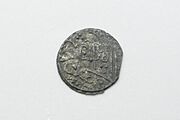
According to a Portuguese writer named Tomé Pires, Demak had more people than any other port in Java. It was also the main exporter of rice to Malacca. Demak's importance grew along with Malacca's. It also helped that Raden Patah claimed to be a direct descendant of the Majapahit royal family. This connection and his family ties with nearby cities made Demak even stronger.
Religion in Demak
Before Demak became a sultanate, many Muslim communities already lived on Java's northern coast. These included foreign traders and local Javanese people. The spread of Islam became faster as the Hindu-Buddhist Majapahit Empire declined.
After the Majapahit capital fell, Raden Patah declared Demak's independence. Almost all the northern Javanese ports then followed Demak and became independent too. However, the Demak royal family still saw themselves as connected to Majapahit. Demak's symbols even used a modified version of the Surya Majapahit, an eight-pointed sun, but without the Hindu meanings. You can still see this symbol inside the Demak Great Mosque.
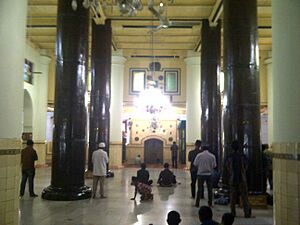
As the first Islamic kingdom in Java, Demak is highly respected by Indonesian Muslims. It is linked to the famous Wali Songo, the nine Muslim scholars who helped spread Islam among the people of Java, who were mostly Hindu-Buddhist at the time. The Demak Great Mosque was built in Demak and is believed to be the oldest mosque still standing in Indonesia. The tombs of the Wali saints and Demak sultans nearby are still visited by Muslims on ziyarat pilgrimages today.
Legends and Legacy
Old Javanese stories, called Babads, tell different tales about how Demak started and grew. But they all agree that Demak was the direct successor to Majapahit. These legends often say that Raden Patah, the first Sultan of Demak, was the son of Majapahit's last king and a Chinese princess. This princess was supposedly sent away from the palace before Patah was born.
These stories suggest that the royal family line continued even after Java became Islamic. Or, it might mean that Demak's rulers used their claimed connection to the Majapahit dynasty to make their rule stronger and more legitimate in the eyes of the people.
See also
- The spread of Islam in Indonesia (1200 to 1600)
- List of monarchs of Java


